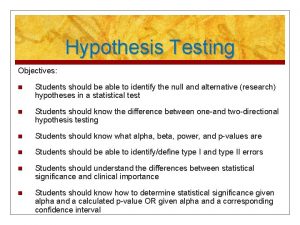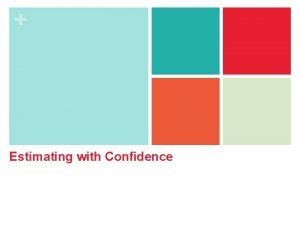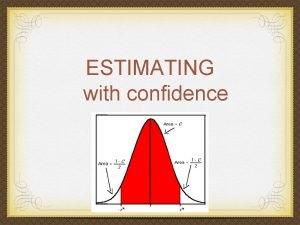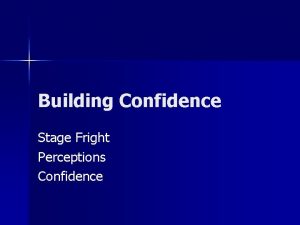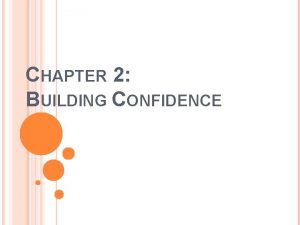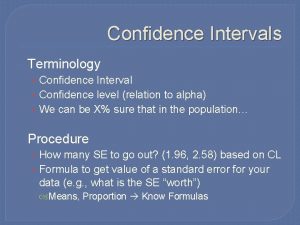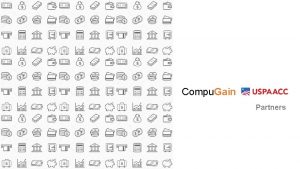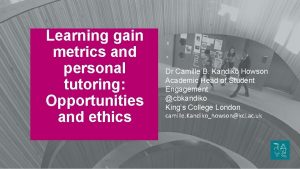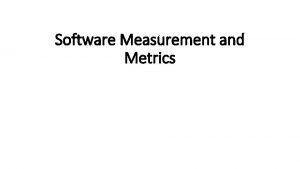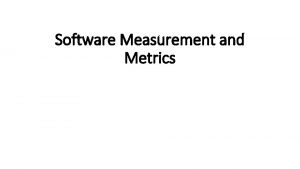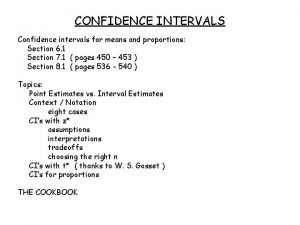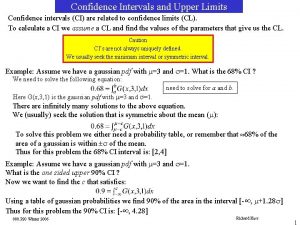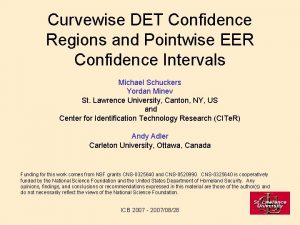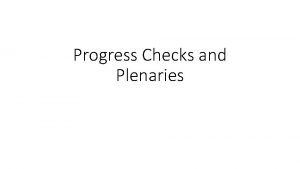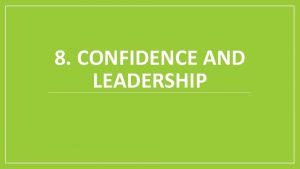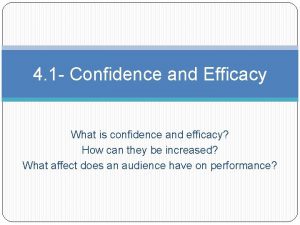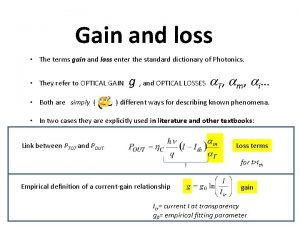Learning Gain and Confidence Gain as Metrics for




























- Slides: 28

Learning Gain and Confidence Gain as Metrics for Pedagogical Effectiveness Fabio R. Aricò Jake Patterson Jacob Shilling DEE – Sep 2017

YOUR PRESENTER Fabio Aricò National Teaching Fellow Senior Lecturer in Macroeconomics School of Economics – University of East Anglia, UK Research fields • Higher Education policy and practice (widen. access, satisfaction) • Technology Enhanced Learning • Self-Assessment and Academic Self-Efficacy Twitter: @Fabio. Arico 2

ACKNOWLEDGEMENTS HEA – Teaching Development Grant Scheme HEFCE Piloting and Evaluating Measures of Learning Gain UEA Students, Alumni, and Research Assistants 3

OUTLINE Part 1 Introduction to main concepts • Peer-instruction, Self-efficacy & Self-assessment, Learning Gain. Part 2 Description of my active learning pedagogy Introduction to my research questions • Operationalising learning/confidence gain Part 3 Empirical methodology and Results • Regression outputs and discussion. 4

1. Introduction to main concepts 5

FLIPPED CLASS and PEER-INSTRUCTION • Flipped classroom & Peer-Instruction pre-reading + student interaction Mazur (1997) Henderson and Dancy (2009) well-developed research in Physics and STEM. • Learning analytics for Peer-Instruction Learning gain: Mazour Group - Bates & Galloway (2012) Student satisfaction: Hernandez Nanclares & Cerezo Menendez (2014). • There is not much literature on the links with self-assessment skills Open field, with many unanswered questions e. g. role of demographics, language, previous background Pedagogically: self-assessment blends with flipping and Peer-instruction. 6

SELF-EFFICACY and SELF-ASSESSMENT Academic Self-Efficacy = confidence at performing academic tasks and/or attaining academic goals. Bandura (1977) 1. Mastery of experiences 2. Vicarious experiences 3. Verbal persuasion 4. Environment and settings See also: Pajares (1996) and Ritchie (2015). Idea: Students should develop their self-efficacy to master their learning experience. Measure learning gain along with increased self-efficacy: ‘confidence gain’. 7

LEARNING GAIN Policy-driven research to assess student learning Arum & Roksa (2010), ‘Academically Adrift’ (US data) OECD approach: assessment of learning outcomes AHELO Project (OECD, 2011 and 2014) US & UK approach: learning gain (‘distance run’ over time) Mc. Grath et al. , 2015 HEFCE commissioned research on piloting measures of learning gain Outputs to feed in Teaching Excellence Framework. 8

2. A description of my active learning pedagogy Research questions 9

ACTIVE LEARNING ENVIRONMENT Introductory Macroeconomics (2015 -16 & 2016 -17) • • • year-long module 250 students 22 lectures 8 seminars 8 workshops (compulsory 1 st year) (about 250 over past 2 years) (2 hrs per week) (every second week, even) (every second week, odd) Students endowed with individual Audience Response Systems (clickers) continuous data collection facilitated by technology; comprehensive ethical approval obtained beforehand. 10

WORKSHOPS – teaching algorithm Round 1 Peer-Instruction Self-Assessment 2 - formative question - students talk - confidence question - 4 choices - compare answers - 4 level Likert-scale - no information - explain each other - information shared - no answer Round 2 Self-Assessment 1 - formative question - confidence question - Identical to R 1 - 4 level Likert-scale - information shared - correct answer 11

RESEARCH QUESTIONS 1. Is the pedagogy developing good self-assessment skills? Are students self-assessing correctly over Round 1/2? 2. Is peer-instruction able to generate learning/confidence gain? How does learning/confidence gain relate to initial knowledge/confidence levels (Round 1)? 3. Is learning gain associated to confidence gain? Does the structure of the algorithm affect this relationship? 2016 Vicarious of Experience Scenario (VES) 2017 Mastery of Experience Scenario (MES) only contrasted with VES (4 sessions each). 12

WORKSHOPS – contrast 2 teaching algorithms VES MES Round 1 Peer-Instruction Self-Assessment 2 - formative question - students talk - confidence question - 4 choices - compare answers - 4 level Likert-scale - no information - explain each other - information shared - no answer Round 2 Self-Assessment 1 - formative question - confidence question - Identical to R 1 - 4 level Likert-scale - information shared - correct answer 13

DATASETS AND CODING Q 1 Q 2 Q 3 1 0 1 1 2 1 0 0 3 1 1 … … … performance per student confidence by student Student Formative questions 1 = correct 0 = incorrect Confidence questions 1 = strongly/agree 0 = strongly/disagree performance per question confidence by question 14

OPERATIONALISING TWO GAINS For each 1 st and 2 nd response to formative assessment questions: Normalised Learning Gain (NLG) = % correct R 2 % correct R 1 100% % correct R 1 For each 1 st and 2 nd response to self-assessment questions: Normalised Confidence Gain (NCG) = % confident R 2 % confident R 1 100% % confident R 1 15

3. Empirical methodology and Results 16

CHANGE IN CONFIDENCE: rough descriptives 2016: only VES 2017: VES & MES 100% 80% 60% 40% C. score 20% K. score 20% 0% 0% 1 3 5 7 2 Week 4 6 8 C. score 1 st K. score 2 nd 1 3 5 VES 7 2 Week 4 6 8 MES Average confidence levels per session Confidence gain is always positive Confidence gain higher with VES (vicarious) and lower with MES (mastery) 17

EMPIRICAL METHODOLOGY Regression analysis at class-level N=140 (2016) and N=136 (2017) Dependent variables: %confident responses, NLG, NCG Independent variables: %correct responses, NLG Workshop Group dummy for 2 Workshop Session dummy for 8 VES/MES Scenario dummy for 2 Functional form: checking for polynomial function Robustness checks: Robust-regression with White-correction (ML estimation of standard errors) 18

RESULT – Self-assessment Skills Round 1 % confident Round 1 2016 VES =0. 429*** R²=0. 56 2017 VES =0. 367*** R²=0. 59 2017 MES = 0. 09*** 0. 44 0. 33 % correct Round 1 19

RESULT – Self-assessment Skills Round 2 % confident Round 2 0. 60 0. 57 2016 VES =0. 282*** R²=0. 26 2017 VES =0. 322*** R²=0. 64 2017 MES = 1. 44*** % correct Round 2 20

RESULT – Normalised Gains in 2016 NLG R²=0. 39 0. 85 NCG 0. 52 NCG R²=0. 19 NLG 2016 0. 37 0. 48 % Correct/Confident in Round 1 21

RESULT – Normalised Gains in 2017 NLG R²=0. 21 0. 67 NCG R²=0. 42 = 0. 132** NLG 0. 40 0. 42 % Correct/Confident in Round 1 22

RESULT – Learning Gain & Confidence Gain NCG 2016 R²=016 2017 VES =0. 19*** R²=0. 39 MES = 0. 125** 0. 31 0. 28 -1 NLG 23

SUMMARY of RESULTS • In both Round 1&2, confidence levels are lower under MES. However, performance and confidence are consistently positively correlated students self-assess correctly, irrespectively of MES/VES scenario. • Peer-instruction generates higher learning/confidence gain when knowledge/confidence in the classroom is neither too high or too low ‘sweet-spot’ pattern does not depend on MES/VES scenario. • Under VES scenario confidence gain is lower, compared to MES scenario. However, confidence gain is consistently positively correlated to learning gain students develop more confidence as they learn, irrespectively of MES/VES scenario. The pedagogy appears to be robust to teacher intervention Active Learning! 24

REFLECTION The active learning environment discussed today combines two powerful pedagogies: self-assessment and peer-instruction. The role of the teacher does affect confidence levels, which are higher when s/he demonstrates (VES). Alterations of the role played by the teacher in either VES or MES do not compromise the effective interaction between students and the benefits generated by the active learning components of the pedagogy. Students support each other in their learning and develop confidence beliefs along with skills. 25

FURTHER RESEARCH • We are pioneering new metrics for learning gain open to criticism, but lots of potential to be explored • Break down data at student level and investigate student typologies characterise gain according to demographics and student engagement • Student-level analysis will be our next step. 26

STAY IN TOUCH! F. Arico@uea. ac. uk @Fabio. Arico “Peer-instruction unveiled: unlocking the power of Student Response Systems” Case Study 15 Jan 2015 @ Economics. Network 27

Learning Gain and Confidence Gain as Metrics for Pedagogical Effectiveness Fabio R. Aricò Jake Patterson Jacob Shilling DEE – Sep 2017
 Confidence interval vs confidence level
Confidence interval vs confidence level 96 confidence interval z score
96 confidence interval z score Cuadro comparativo de e-learning
Cuadro comparativo de e-learning Kontinuitetshantering
Kontinuitetshantering Novell typiska drag
Novell typiska drag Tack för att ni lyssnade bild
Tack för att ni lyssnade bild Returpilarna
Returpilarna Varför kallas perioden 1918-1939 för mellankrigstiden
Varför kallas perioden 1918-1939 för mellankrigstiden En lathund för arbete med kontinuitetshantering
En lathund för arbete med kontinuitetshantering Adressändring ideell förening
Adressändring ideell förening Vilotidsbok
Vilotidsbok Anatomi organ reproduksi
Anatomi organ reproduksi Densitet vatten
Densitet vatten Datorkunskap för nybörjare
Datorkunskap för nybörjare Tack för att ni lyssnade bild
Tack för att ni lyssnade bild Att skriva en debattartikel
Att skriva en debattartikel Delegerande ledarskap
Delegerande ledarskap Nyckelkompetenser för livslångt lärande
Nyckelkompetenser för livslångt lärande Påbyggnader för flakfordon
Påbyggnader för flakfordon Kraft per area
Kraft per area Publik sektor
Publik sektor Kyssande vind
Kyssande vind Presentera för publik crossboss
Presentera för publik crossboss Jiddisch
Jiddisch Vem räknas som jude
Vem räknas som jude Treserva lathund
Treserva lathund Epiteltyper
Epiteltyper Bästa kameran för astrofoto
Bästa kameran för astrofoto Cks
Cks
